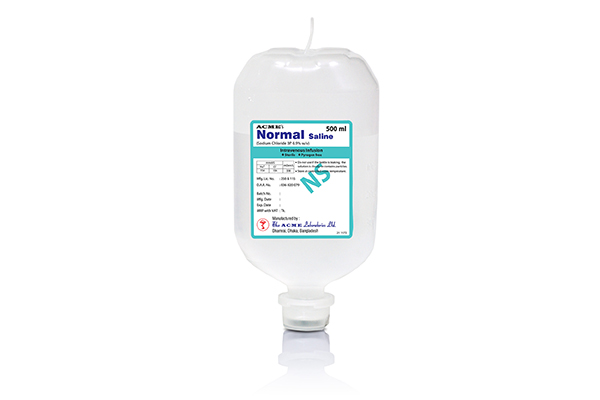Significance of Normal Saline in Medical Practice

Normal saline
Normal saline, a fundamental solution in medical settings, plays a pivotal role in various healthcare applications. Composed of sodium chloride in a concentration mirroring that of bodily fluids, normal saline is an isotonic solution that finds extensive use in clinical settings, ranging from intravenous hydration to wound care. This article explores the properties, applications, and significance of normal saline in the realm of medical practice.
Composition and Properties:
Normal saline, also known as 0.9% sodium chloride solution, is a sterile mixture of sodium chloride (NaCl) and water in proportions that closely resemble the electrolyte composition of the human body. This isotonic solution has an osmolarity of approximately 308 mOsm/L, ensuring compatibility with the body’s fluids and minimizing the risk of cellular damage or fluid overload.
The balanced composition of normal saline makes it a versatile and safe solution for medical interventions. Its isotonic nature prevents the disturbance of cellular functions, making it suitable for a wide range of medical applications.
Clinical Applications:
1. Intravenous Fluid Replacement:
One of the most common applications of normal saline is as an intravenous (IV) fluid for hydration. Whether in hospital settings, emergency rooms, or outpatient clinics, healthcare professionals frequently administer normal saline to replenish fluids in patients experiencing dehydration due to various conditions, such as vomiting, diarrhea, or surgical procedures.
2. Blood Transfusion and Medication Administration:
Normal saline serves as a compatible medium for diluting and administering medications and blood products. It is often used as a vehicle for intravenous drug administration, facilitating the controlled delivery of medications to patients. Additionally, it can be employed in blood transfusions to ensure the safe and efficient transfer of blood components.
3. Wound Care:
Normal saline is an essential tool in wound care and irrigation. Its sterile nature makes it ideal for cleansing wounds, promoting the removal of debris and preventing infection. Healthcare providers frequently use normal saline to clean and irrigate wounds, aiding in the healing process.
4. Resuscitation:
In emergency situations, such as cardiac arrest or shock, normal saline is a critical component of resuscitation efforts. Rapid administration of isotonic fluids helps restore blood volume and maintain vital organ perfusion, increasing the chances of patient survival.
5. Diagnostic Procedures:
Normal saline is often employed in diagnostic procedures, such as intravenous pyelogram (IVP) and certain imaging studies. Its isotonic nature allows it to be safely introduced into the body, facilitating visualization of internal structures without causing cellular damage.
Significance in Pediatric and Geriatric Care:
Normal saline is particularly valuable in pediatric and geriatric care due to its compatibility with individuals across a broad age spectrum. In pediatric settings, it is commonly used for rehydration in cases of diarrhea or gastroenteritis. Similarly, in geriatric care, where patients may have compromised kidney function or fluid balance, normal saline provides a well-tolerated means of maintaining hydration.
Considerations and Precautions:
While normal saline is generally safe and well-tolerated, healthcare providers must consider individual patient needs and conditions. Patients with specific medical conditions, such as heart failure or renal impairment, may require adjusted fluid regimens. Monitoring electrolyte levels and addressing any signs of fluid overload are crucial aspects of responsible clinical practice.
Conclusion:
Normal saline stands as a cornerstone in medical practice, serving as a versatile and indispensable solution for a myriad of applications. From intravenous hydration to wound care, its isotonic composition makes it a safe and effective choice for patients across diverse age groups and medical conditions. As healthcare continues to evolve, the role of normal saline remains integral, showcasing its enduring significance in promoting patient well-being and optimal clinical outcomes.







